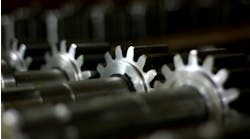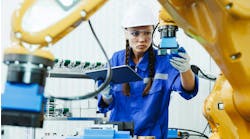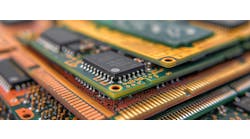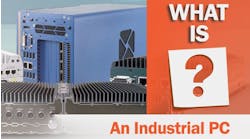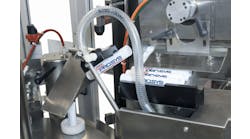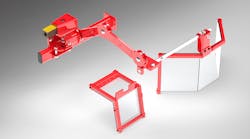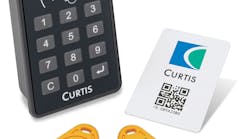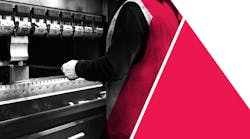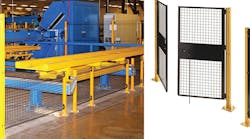When a machinist is cutting, drilling, shaping or milling raw materials, there are always inherent risks. Thankfully, proper and up-to-date safeguarding equipment drastically minimizes the risks that machines pose. In this article, we look at one of the most basic and most critical components in machine safeguarding: the safety shield.
Before we start, we need to clarify the terms “guard” and “shield”. These are often used interchangeably when referring to safeguarding equipment, yet the two categories are very different. OSHA 29 CFR 1910.217 defines a guard as an enclosure that prevents anyone from reaching over, under, around, or through to a hazard. Guards are used whenever a machine risk assessment shows a high level of exposure to recognized hazards. Shields, on the other hand, are designed for lower levels of exposure to hazards, while providing visibility into the point of operation. That’s the key difference: Shields typically have a transparent plastic panel with rugged framing, while a guard is solid metal. It should be noted that not all shields have a framework and that many industrial guards use aluminum for the framework.
Flying Debris Protection
The purpose of safety shields is to protect the machinist and bystanders from moving parts, flying debris, coolant, sparks, and other potential safety hazards by providing a barrier between plant personnel and the identified hazard. Shields attach to machinery, either temporally or permanently, fitting over blades, cutting tools, chucks, grinding stones, and other hazardous rotating components.
Perhaps the greatest danger shields guard against is flying debris, an all-too-common occurrence in machine shops with the potential to bring about serious injury to an operator's eyes, face, or body, as well as to those in the immediate area of the machine. The costs of a flying debris injury can add up quickly. Costs may include workers' compensation claims, medical expenses, lost production time, and the possibility of permanent scarring and blindness.
For instance, consider an abrasive wheel grinder. One of the most common pieces of machinery in maintenance shops, wheel grinders are powerful and operate at very high speeds. Depending on the equipment, the wheels can revolve at an incredible 10,000 surface feet per minute and can loosen sharp chips or particles that can fly into an operator’s eyes or face. In situations like this, a safety shield is the last line of defense against tragedy. Even if the operator is wearing proper personal protective equipment, flying chips can cause life-threatening injuries without a shield installed. It can make the difference between a day that ends successfully and one that ends in the hospital.
Safety Standards
Given their critical importance to operator safety, it is not surprising that ANSI, OSHA, and other standards governing machine safeguarding heavily rely upon shields. Specific requirements largely depend on the type of machinery being safeguarded. Before installing a new shield on any machine the safety manager must ensure that the shield conforms to the appropriate, up-to-date standard for that machine.
Besides grinders, shields are typically installed on drilling machines, lathes, milling machines, saws, belt sanders, and sanding machines, and boring machines. The eight machines represent over 95 percent of all shielding applications. Different standards outline the type of shield design and size that is allowed on each. In some cases, more than one type of shield per machine may be necessary to provide protection.
| Machine | ANSI/OSHA Standard |
| Drilling Machine | ANSI B11.8 |
| Lathes | ANSI B11.6 |
| Milling Machines | ANSI B11.8 |
| Grinders | OSHA 29 CFR 1910.215 / ANSI B11.6, B7 |
| Band/Table Saws | OSHA 29 CFR 1910.212, 1910.213 / ANSI B11.10 |
| Disc/Belt Sanders | OSHA 29 CFR 1910.212, 1910.213 |
Types of Shields
Shields come in dozens of designs, sizes, and shapes. In their most basic form, they can be broken out into fixed, portable, adjustable, and interlocked categories, or a mixture of these features.
FIXED/PORTABLE
The most obvious characteristic of a fixed shield is that it is a permanent part of the machine. Tools are needed for its removal making it difficult to bypass. It is also not dependent upon other moving parts to perform its intended function, further increasing the protection. In contrast, a portable shield can be removed from the machine when not in use. Often, smaller shields will feature a pull magnetic base that attaches to a flat surface on the machine being safeguarded. Being removable, portable shields can be set aside for maintenance or moved to a similar machine. There are also large freestanding portable shields used to protect the area between machines, along aisles, or the backside of a machine.
ADJUSTABLE
An adjustable shield can be positioned for maximum protection during operation and swung out of the way for easy access to the workpiece and tooling. Types of adjustable shields are those mounted on brackets that allow for slide adjustments to fit workpieces; on steel ball-and-socket arms for simple movements and adjustments, or on flexible spring-steel arms offering virtually unlimited adjustment possibilities and long-term holding power.
INTERLOCKED
It is best practice that shields featuring movable parts that can be opened without using tools should be interlocked with the machine control system. The interlock prevents machines from starting until the shield is positioned safely in front of the hazardous area. Additionally, if the shield is moved away from the hazardous area while the machine is running, the interlock will send a stop signal to turn the machine off.
Modern machines rely on electrical interlocks since they are already fitted with an electrical control system. The interlock is connected to the safety circuit of the machine and will prevent machine start-ups when the shield is swung open, even if the power switch is “ON”. It is only after the shield is closed that the machine can be restarted and normal operation resumed. A safety relay will monitor the interlock switch for failure, providing a notification if the interlock has been removed or is not functioning correctly.
Impact Resistance
A transparent shield needs to be highly impact-resistant, along with providing an unobstructed and undistorted view. The impact resistance of a material can be measured in different ways, and the test method varies depending on the material being evaluated. In the United States, the notched Izod impact resistance test, as outlined in ASTM D256, is a common method of measuring the toughness of a plastic material.
It is important to note that increasing the thickness of a shield beyond a certain level does not always improve or increase impact resistance. A shield made of tougher material can be down-gauged to be thinner — and, therefore, more cost-effective — than one made from a more brittle material while still offering the same or superior level of protection for operators.
Innovations
Companies are bringing new materials and features to the product category that are enhancing operator safety yet making it less expensive for machine shops to be fully compliant with regulations.
An example of this new problem-solving advancement is the incorporation of bright LED lighting into the shield frame to yield higher visibility of the work area. Operators have often complained that shields limit visibility because of reflectivity or obstruction. Unlike incandescent, LED lighting is not-reflective, cool, and renders true colors. Besides the white lighting illuminating the work area while in operational mode, different LED colors can be programmed to act as visual indicators. For example, when the shield is moved out of the safe work position, the white LED can switch off automatically and the red LED can switch on to warn the operator. If you plan to purchase a shield with an LED be aware that the lighting must be manufactured to exacting IEC IP65 outdoor/wet locations standards to withstand splashes of coolant and lubricant from the machine.
Another innovation is modularity. Different machines require different shields, and one size rarely fits all. Shield manufacturers have embraced the modular design concept so that shield shape, size, mount, arm, offset, lighting, interlocking, and safety monitoring can be configured to engineer the best solution for even the most unique challenge. Shields are vertically and horizontally adjustable to clear varying work setups and table heights.
Finally, there is the issue of operators bypassing shields, either by pushing them out of the way or tampering with the equipment.
Tamper-resistant interlock switches go a long way towards stopping bypassing. However, a quality shield that doesn’t interfere with the operation of a machine is a better answer. A shield defeats its purpose if it impedes a worker from performing a job quickly and comfortably. When properly installed and designed for a specific machine, a shield will actually enhance efficiency because it will relieve apprehensions about an injury.
